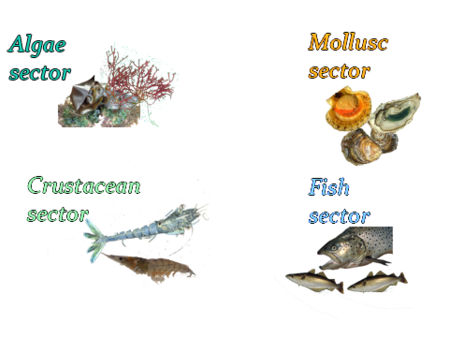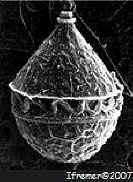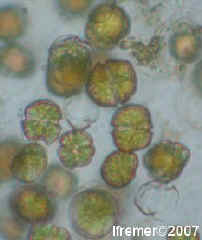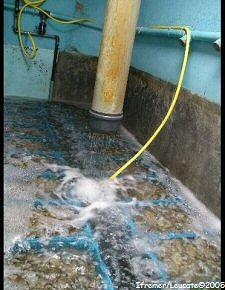The COMSAUMOL project
Project Sheet 2007 Jean-Louis Martin
http://en.aquaculture.ifremer.fr/Info.-Card
Study Context
The increase in toxicity events caused by certain phytoplankton species has led Ifremer to start a new research program called GET (Gestion des Efflorescences Toxiques – Toxic Bloom management).
This program has three principal objectives:
- Optimisation of monitoring tools for the algal species and toxins
- Forecasting of toxicity events on the coast
- Protection of shellfish stocks
COMSAUMOL is the main part of the third GET objective, as it will enable the development of generic procedures that can be applied to a great number of specific cases.
Toxic phytoplankton and shellfish
In recent months, sale prohibitions have been imposed in numerous shellfish production sites for several weeks, following the appearance of toxic algal blooms.
These closures bring about serious economic losses for the shellfish farming profession and can also make consumers wary of shellfish.
The project
Following a request from the CNC, Ifremer proposed the CONSAUMOL research action. Its name stands for " maintien de la COMmercialisation par la SAUvegarde et la détoxification des MOLlusques" (Maintenance of shellfish sales by protection and detoxification of molluscs).
The objective of this research action, conducted as a partnership between Ifremer (J. Haure) and the University of Nantes (P. Jaouen), is to answer the following question:
"What means can businesses use on land to minimise the economic impact of the appearance of toxic algae in their production sites?"
This project was approved by the COSTE (Comité d’Orientation Scientifique et Technique et d’Evaluation - Scientific and technical orientation and evaluation committee) and the PFPA (Pôle Filière Produits Aquatiques - Centre for the aquatic product industry). Several regional government councils have already agreed to give financial support for the project.
Objective
The principal objective of this study is to be able to give shellfish producers the necessary means and techniques to use in such circumstances, and that these be transferable on a national level to all shellfish farming basins that suffer from toxic algal blooms.
However, the conception of generic processes must take into account the specificities of differing alternative water sources (subterranean water, percolated water, decanted water etc.), specific to each basin, for later feasibility studies.
These studies will be completed by cost estimation of the procedures to appraise economic feasibility.
Finally, it will be essential to consider additional uses of the procedures that can help to make the best possible overall use of the material so as to compensate for the investment made in times other than crisis periods (e.g. quality-adding finishing stages in shellfish production).
Stages of the program
Introduction: Stocking oysters
Outside of toxic bloom crisis periods, shellfish can be stocked in ponds or out of water at low temperature. This stocking is usually for short term periods (less than a week), the low water temperature (stocking before the Christmas-New Year period), or air temperature (cold room) allow the shellfish to maintain their flesh weight. With stocking in ponds, the seawater is most often oxygenated and regularly replaced to remove solid and dissolved waste.
Of the processes that could be developed in this study, it is firstly necessary to define the limits of each depending on their uses and the expectations of the oyster farming profession. The different procedures that can be envisaged are as follows:
Stocking shellfish before crises
This is the protection of saleable products on land during crisis periods. Stocking could be done in or out of water, depending on the results of this study, and must meet the quality criteria demanded by the industry and official sanitary control services.
It must be possible to lengthen the stocking period for several weeks depending on the duration of the toxicity crisis. If water without algal contamination is not freely available (subterranean salt water for example), then the process must employ recirculation techniques for economy.
One additional point is that this type of stocking will not require treatment of out-going water, as shellfish stocked should be clean and free of toxins at the point they enter the stocking structure.
Water treatment processes should however be studied for the water supply and maintenance of clean seawater in a closed circuit.
Finally, for the cases where the length of the market closure of field sites has to be prolonged for several weeks, processes will be studied that can guarantee the maintenance of flesh quality (low temperature and/or feeding). The proposed system should allow the shellfish that are sold to be replaced by bringing in new batches of clean animals, while maintaining most of the water in a secure circuit.
Shellfish detoxification
This method will be for use when pre-contamination stocking methods cannot be put into action in time. The objective will be to reduce shellfish toxicity as quickly as possible to a threshold acceptable for consumption.
Studies will be orientated towards the inputs of food algae and/or clays to accelerate shellfish decontamination. In this case the effluents must be treated to avoid propagation of toxic algae in the natural environment.
Shellfish finishing stages
Work on these stages brings together all the processes for the improvement of shellfish flesh quality by the input of feed algae.
To start with, such techniques can only be considered in an open system outside of toxic bloom risk periods. It will therefore be a manner of putting the infrastructure for crises to another profitable use that will help to cover the cost.
Photo credits: Ifremer Nantes (P. Lassus) / Bouin (J. L. Martin)/ Ifremer Sète (J. Barret)




